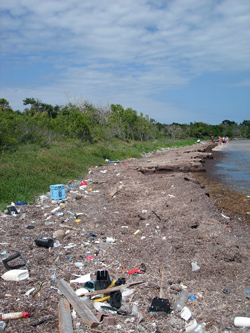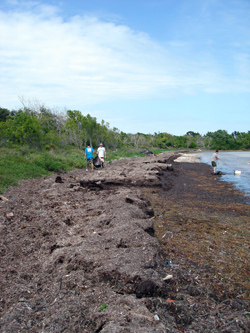
Endangered sea turtles draw visitors
HOMESTEAD, Fla.— For many South Florida residents who visit Biscayne National Park, one of the main attractions is the opportunity to see the endangered aquatic wildlife that live within its 173,000 acres, of which 95 percent are covered in water.
According to the 2005 Biscayne National Park Sea Turtle Monitoring Program report, there are five different types of sea turtles that inhabit the park: Loggerhead, Hawksbill, Kemp’s Ridley, Green and Leatherback.
Each one is considered either endangered or threatened by the Endangered Species Act of 1973.
“I remember my first visit to the park. It was during a third grade field trip. My teachers had spent the previous month teaching our class about all the interesting animals that lived there and I couldn’t wait to see them. The sea turtles were my favorite because of their huge shells and cute faces,” recalled Kristin Cline, 22.
  |
| Palm Beach at Biscayne National Park was cleaned in 2007. The effort made a noticeable difference (Photo courtesy of the Sea Turtle Nesting Protection Program at Biscayne National Park). |
Although Cline did not actually get to see any of the turtles during her visit, the ranger that gave her class the tour of Elliott Key did point out some of their newly laid nests.
Unfortunately for both future visitors and environmentalists, successful sea turtle nesting and hatching are becoming rare within Biscayne National Park. In order to protect the rapid decline of the sea turtle population, the Biscayne National Park Resource Management Division created the Sea Turtle Nesting Protection Program, which has been recording and monitoring nests for the last 14 years.
Biscayne National Park personnel, interns and dedicated volunteers conduct clean-ups of the nesting areas before the nesting season begins.
“The goal of the nesting program is to establish and maintain a baseline inventory and monitoring program for protecting sea turtle nesting and hatching activities within the Park, to identify and monitor the temporal and spatial distribution of sea turtle activity within the Park, to participate in and support the Sea Turtle Stranding and Salvage Network (STSSN) and to identify and mitigate the natural and anthropogenic threats to the turtles, their nests, and hatchlings,” said Shelby Moneysmith, director of the Sea Turtle Nesting Protection program.
During the season, they monitor the park’s beaches, keeping detailed accounts of all the information pertaining to the nests that they find. In addition, they try to protect the nests from predation by raccoons, which is the primary source of nest destruction.
“They’re trying to get to the nest and put a home-made fence over it before the raccoons have a change to pillage the eggs,” said Maria Beotegui, head of the Environmental Education Program at Biscayne National Park.
The protective netting is actually a “self-releasing screen” that is placed over the nest. The flat wire screen is spaced wide enough apart to allow newly hatched turtles to emerge but close enough together to prevent predators from reaching the eggs.
| Interns Charlie and Olga at a turtle nesting site (Photo courtesy of the Sea Turtle Nesting Protection Program at Biscayne National Park). |  |
In addition to placing nets on top of the turtle nests, the park staff also removes debris from the beaches during nesting season so they are more conducive to nesting.
“We are losing nesting habitat due to debris,” said Moneysmith.
Sea turtle nesting season generally occurs in Florida from May until late August or early September. The Loggerhead and Hawksbill Turtles are the only two types to have ever been recorded nesting on the approximately 10 beaches located within Biscayne National Park.
The 2005 Biscayne National Park Sea Turtle Monitoring Report noted that the overwhelming majority of nests found have been attributed to Loggerhead Turtles. Only four Hawksbill Turtle nests have been identified since 1980.
Of the four nests recorded in 2005, the report stated “two nests were completely predated by raccoons” despite the aid of protective nets.
In addition, one of the four was completely destroyed by a tidal wave during Hurricane Wilma.
These figures are even more significant when evaluated from a world-wide perspective.
According to the National Marine Fisheries Service’s website, South Florida is one of only two destinations in the world where over 10,000 Loggerhead Sea Turtle nestings occur per year.
According to the Florida’s Fish and Wildlife Research Institute (FFWRI), this means that approximately 90 percent of the world’s population of Loggerheads nests in Florida.
In a report published in 2006 that surveyed the Loggerhead Turtle nest counts from 1989-2005, the FFWRI found: “There has been a 22.3% decrease over the 17 yr. period, and a 39.5% decline since 1998.”
“It is really depressing,” said Beotegui, “However, efforts and monitoring increased so much in 2006 because of the 2005 report”.
To help monitor and prevent a further decline in these dismal figures, park sea turtle nesting personnel are doubling their efforts by inventorying shorelines more frequently and earlier in the season to place more netting, and making presentations in the community to educate others about the situation.
“It is the park’s goal to protect it and the sea turtles in hopes that they will continue to utilize this habitat in the future,” said Moneysmith.

Comments are Closed